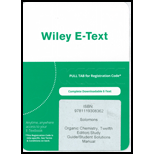
Concept explainers
Interpretation:
The structures of each intermediates and of muscalure formed in the reaction are to be given.
Concept Introduction:
The reaction of
Electrophiles are electron deficient species which has positive or partially positive charge. Lewis acids are electrophiles which accept electron pair.
Nucleophiles are electron rich species which has negative or partially negative charge. Lewis bases are nucleophiles which donate electron pair.
Free radical is an atom, molecule or ion that has unpaired electrons which makes it highly chemically reactive.
Substitution reaction: A reaction in which one of the hydrogen atoms of a hydrocarbon or a
Elimination reaction: A reaction in which two substituent groups are detached and a double bond is formed is called elimination reaction.
Addition reaction: It is the reaction in which unsaturated bonds are converted to saturated molecules by the addition of molecules.
Carbocation is a molecule having a carbon atom bearing three bonds and a positive formal charge.
Carbocation are generally unstable because they do not have eight electrons to satisfy the octet rule.
The order of stability of carbocation is such that the tertiary carbocation is the most stable whereas the primary carbocation is the least stable, and secondary carbocation lies between primary and tertiary carbocations.
If primary carbocation is obtained in product, it rearranges itself to secondary or tertiary carbocation to form more stable product.
If secondary carbocation is obtained in product, it rearranges itself to tertiary carbocation to form more stable product.
The stability of carbocation:
Want to see the full answer?
Check out a sample textbook solution
Chapter FRP Solutions
ORGANIC CHEMISTRY-ETEXT REG ACCESS
- Both pyridine and pyrrole are nitrogen containing aromatic heterocyclic compounds. When treated with HCl, only pyridine forms the hydrochloride salt, where as pyrrole is unreactive. What is the best explanation for this observed reactivity.arrow_forwardPropose a reasonable synthesis of the following reaction:.arrow_forwardGive the suitable synthesis to accomplish the following transformation.arrow_forward
- Safrole, which is isolated from sassafras (Problem 21.33), can be converted to the illegal stimulant MDMA (3,4- methylenedioxymethamphetamine, “Ecstasy”) by a variety of methods. (a) Devise a synthesis that begins with safrole and uses a nucleophilic substitution reaction to introduce the amine. (b) Devise a synthesis that begins with safrole and uses reductive amination to introduce the amine.arrow_forwardStarting exactly with any acid chloride with exactly with 5 carbon atoms, and using appropriate reagents outline the synthesis of the following molecules:arrow_forwardPractice Problem 18.39 Rank the following compounds in order of increasing reactivity toward electrophilic aromatic substitution. Br A B Br Br E Increasing reactivity toward electrophilic aromatic substitutionarrow_forward
- Safrole, which is isolated from sassafras (Problem 21.33), can be converted to the illegal stimulant MDMA (3,4-methylenedioxymethamphetamine, "Ecstasy") by a variety of methods. (a) Devise a synthesis that begins with safrole and uses a nucleophilic substitution reaction to introduce the amine. (b) Devise a synthesis that begins with safrole and uses reductive amination to introduce the amine. NHCH9 MDMA safrolearrow_forwardPractice Problem 19.54 Z Your answer is partially correct. Try again. Predict the major product(s) (A - K) from the treatment of acetone with the following compounds (a-c): NH2 HO Eto OEt A: B: C: D: E: F: OH OH но CN G: H: I: J: (a) [H*], excess EtOH, (-H20) Major Product(s): (ь) NaBH4, Meон B Major Product(s): (c) LAH followed by H20 Major Product(s): SHOW HINTarrow_forwardRank the compounds in each of the following groups in order of their reactivity to electrophilic substitution: (a) Nitrobenzene, phenol, toluene, benzene (b) Phenol, benzene, chlorobenzene, benzoic acid (c) Benzene, bromobenzene, benzaldehyde, anilinearrow_forward
 Organic ChemistryChemistryISBN:9781305580350Author:William H. Brown, Brent L. Iverson, Eric Anslyn, Christopher S. FootePublisher:Cengage Learning
Organic ChemistryChemistryISBN:9781305580350Author:William H. Brown, Brent L. Iverson, Eric Anslyn, Christopher S. FootePublisher:Cengage Learning
